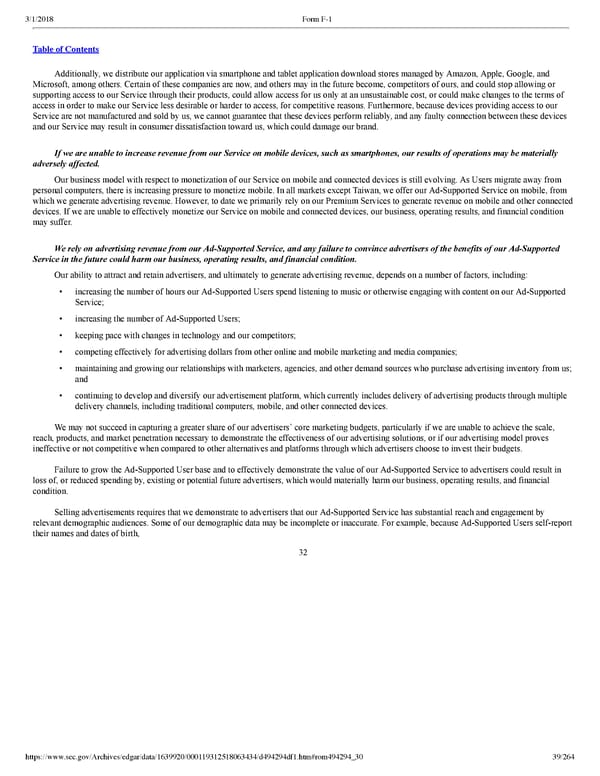39/264 Additionally, we distribute our application via smartphone and tablet application download stores managed by Amazon, Apple, Google, and Microsoft, among others. Certain of these companies are now, and others may in the future become, competitors of ours, and could stop allowing or supporting access to our Service through their products, could allow access for us only at an unsustainable cost, or could make changes to the terms of access in order to make our Service less desirable or harder to access, for competitive reasons. Furthermore, because devices providing access to our Service are not manufactured and sold by us, we cannot guarantee that these devices perform reliably, and any faulty connection between these devices and our Service may result in consumer dissatisfaction toward us, which could damage our brand. If we are unable to increase revenue from our Service on mobile devices, such as smartphones, our results of operations may be materially adversely affected. Our business model with respect to monetization of our Service on mobile and connected devices is still evolving. As Users migrate away from personal computers, there is increasing pressure to monetize mobile. In all markets except Taiwan, we offer our AdSupported Service on mobile, from which we generate advertising revenue. However, to date we primarily rely on our Premium Services to generate revenue on mobile and other connected devices. If we are unable to effectively monetize our Service on mobile and connected devices, our business, operating results, and financial condition may suffer. We rely on advertising revenue from our AdSupported Service, and any failure to convince advertisers of the benefits of our AdSupported Service in the future could harm our business, operating results, and financial condition. Our ability to attract and retain advertisers, and ultimately to generate advertising revenue, depends on a number of factors, including: • increasing the number of hours our AdSupported Users spend listening to music or otherwise engaging with content on our AdSupported Service; • increasing the number of AdSupported Users; • keeping pace with changes in technology and our competitors; • competing effectively for advertising dollars from other online and mobile marketing and media companies; • maintaining and growing our relationships with marketers, agencies, and other demand sources who purchase advertising inventory from us; and • continuing to develop and diversify our advertisement platform, which currently includes delivery of advertising products through multiple delivery channels, including traditional computers, mobile, and other connected devices. We may not succeed in capturing a greater share of our advertisers’ core marketing budgets, particularly if we are unable to achieve the scale, reach, products, and market penetration necessary to demonstrate the effectiveness of our advertising solutions, or if our advertising model proves ineffective or not competitive when compared to other alternatives and platforms through which advertisers choose to invest their budgets. Failure to grow the AdSupported User base and to effectively demonstrate the value of our AdSupported Service to advertisers could result in loss of, or reduced spending by, existing or potential future advertisers, which would materially harm our business, operating results, and financial condition. Selling advertisements requires that we demonstrate to advertisers that our AdSupported Service has substantial reach and engagement by relevant demographic audiences. Some of our demographic data may be incomplete or inaccurate. For example, because AdSupported Users selfreport their names and dates of birth, 32
 Spotify F1 | Interactive Prospectus Page 38 Page 40
Spotify F1 | Interactive Prospectus Page 38 Page 40